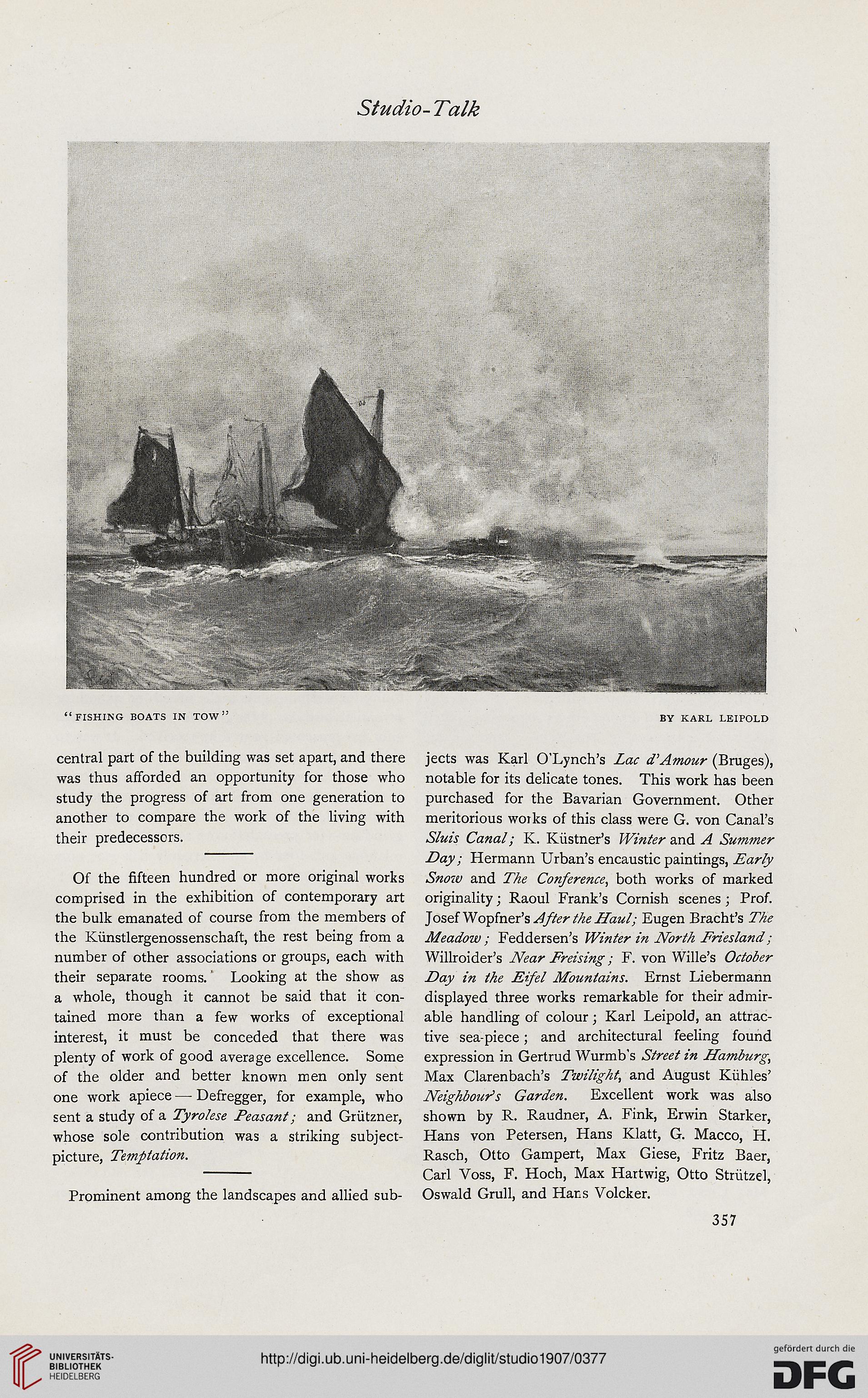Studio- Talk
central part of the building was set apart, and there
was thus afforded an opportunity for those who
study the progress of art from one generation to
another to compare the work of the living with
their predecessors.
Of the fifteen hundred or more original works
comprised in the exhibition of contemporary art
the bulk emanated of course from the members of
the Kunstlergenossenschaft, the rest being from a
number of other associations or groups, each with
their separate rooms. Looking at the show as
a whole, though it cannot be said that it con-
tained more than a few works of exceptional
interest, it must be conceded that there was
plenty of work of good average excellence. Some
of the older and better known men only sent
one work apiece — Defregger, for example, who
sent a study of a Tyrolese Peasant; and Griitzner,
whose sole contribution was a striking subject-
picture, Temptation.
Prominent among the landscapes and allied sub-
jects was Karl O'Lynch's Lac d'Amour (Bruges),
notable for its delicate tones. This work has been
purchased for the Bavarian Government. Other
meritorious wotks of this class were G. von Canal's
Sluts Canal; K. Kiistner's Winter and A Summer
Day ; Hermann Urban's encaustic paintings, Early
Snow and The Conference, both works of marked
originality; Raoul Frank's Cornish scenes ; Prof.
JosefWopfner's After the Haul; Eugen Bracht's The
Meadow ; Feddersen's Winter in North Friesland;
Willroider's Near Fret sing; F. von Wille's October
Day in the Eifel Mountains. Ernst Liebermann
displayed three works remarkable for their admir-
able handling of colour; Karl Leipold, an attrac-
tive sea-piece; and architectural feeling found
expression in Gertrud Wurmb's Street in Hamburg,
Max Clarenbach's Twilight, and August Kuhles'
Neighbour's Garden. Excellent work was also
shown by R. Raudner, A. Fink, Erwin Starker,
Hans von Petersen, Hans Klatt, G. Macco, H.
Rasch, Otto Gampert, Max Giese, Fritz Baer,
Carl Voss, F. Hoch, Max Hartwig, Otto Striitzel,
Oswald Grull, and Hans Volcker.
357
central part of the building was set apart, and there
was thus afforded an opportunity for those who
study the progress of art from one generation to
another to compare the work of the living with
their predecessors.
Of the fifteen hundred or more original works
comprised in the exhibition of contemporary art
the bulk emanated of course from the members of
the Kunstlergenossenschaft, the rest being from a
number of other associations or groups, each with
their separate rooms. Looking at the show as
a whole, though it cannot be said that it con-
tained more than a few works of exceptional
interest, it must be conceded that there was
plenty of work of good average excellence. Some
of the older and better known men only sent
one work apiece — Defregger, for example, who
sent a study of a Tyrolese Peasant; and Griitzner,
whose sole contribution was a striking subject-
picture, Temptation.
Prominent among the landscapes and allied sub-
jects was Karl O'Lynch's Lac d'Amour (Bruges),
notable for its delicate tones. This work has been
purchased for the Bavarian Government. Other
meritorious wotks of this class were G. von Canal's
Sluts Canal; K. Kiistner's Winter and A Summer
Day ; Hermann Urban's encaustic paintings, Early
Snow and The Conference, both works of marked
originality; Raoul Frank's Cornish scenes ; Prof.
JosefWopfner's After the Haul; Eugen Bracht's The
Meadow ; Feddersen's Winter in North Friesland;
Willroider's Near Fret sing; F. von Wille's October
Day in the Eifel Mountains. Ernst Liebermann
displayed three works remarkable for their admir-
able handling of colour; Karl Leipold, an attrac-
tive sea-piece; and architectural feeling found
expression in Gertrud Wurmb's Street in Hamburg,
Max Clarenbach's Twilight, and August Kuhles'
Neighbour's Garden. Excellent work was also
shown by R. Raudner, A. Fink, Erwin Starker,
Hans von Petersen, Hans Klatt, G. Macco, H.
Rasch, Otto Gampert, Max Giese, Fritz Baer,
Carl Voss, F. Hoch, Max Hartwig, Otto Striitzel,
Oswald Grull, and Hans Volcker.
357




